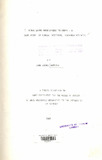| dc.description.abstract | The last fifteen years have witnessed increasing
attention being focused by the Kenya Government on the
needs of the rural areas in the country in an effort to
raise rural standards of living as part of the overall
strategy for economic development .. As part of the new
emphasis, the improvement of the health of the rural
population through the provision of clean water has been
identified as an essential component. To this end, the
Kenya Government has undertaken as its national policy,
the eventual provision of piped water supplies to the
entire population in the country, by the year 2000. This
is a major undertaking, since the rural population accounts
for over 80% of the total population in Kenya.
This study concerns itself with a detailed examination
of some of the problems likely to be encountered by the
Government in its attempt to implement the implied policy
declaration, to provide "piped water for all". The study
accepts. the basic assumption that effective design and
development of water supply projects in the rural areas
of Kenya is an essential constituent for stimulating
the economic development of these areas. The success
.
of such projects is dependent upon many considerations,
which are closely linked with efforts at raising rural
living standards.
- ii -
Vihiga Division of Kakamega District was selected
because it was regarded as being ideal for the study.
Although it is located in a wet Dart of Kenya, it has a
very high rural population density (about 1000 per
square kilometre) and n equ~ lly rapid population growth
rate of 4.1 percent per annum. It has been asswned that
the population issue is bound to manifest itself in the
provision of rural water supplies in the Division. The
main objective of this study was to derive a general
theory on the fundamental concepts of water supply
development in Vihiga Division. In this context, the
general null-hypothesis investigated states that
envir6nmental and socio-economic factors do not
significantly affect water supply development in Vihiga
Division.
Regression analysis was used on part of the data
collected in the field, covering factors impinging upon
rural water supply development. Statistically
significant relationships were found to exist when socioeconomic
data such as household population education /
distance to and fro~ water source, per capita water
consumption /and time. t.aken to fetch water, were
regressed.
The study also includes an investigation into
selected environmental factors influencing water
development. It revealed that Vihiga Division has
- iii -
many natural advantages. For example; it has good
acaui~ers and ample natural sources of water supply.
l!owever because of the high population density most of
these sources are liable to pollution, thereby posing
a clear health hazard. It is for this reason that
~reated water supplies are necessary.
Unfortunately treated supplies require piped
connections to communal points or to individual
households. It is expensive to supply each family with
Individual connections and a majority of the rural
people cannot afford to pay for them. The high cost of
pipes and fittings is therefore a major hinderance to the
provision of piped water supplies to rural families.
These and other findings suggest that economic
considerations constitute a major problem in the
provision of piped water supplies not only in Vihiga
Division, but in many similarly affected areas of rural
Kenya.
It is concluded that any efforts to quicken the pace
of rural water supply development, must address itself
particularly to the question of rural incomes.Development
planners will also need to evaluate the present
strategies used to supp~y piped water to rural areas and
suggest cheaper alternatives. The value of self-help
in the achievement of water development targets needs to
be emphasised, as the current level of participation in
Vihiga Division is rather low.
Recommendations for further research include the need
for a study ~f the efficiency with which the current
water supply projects are executed, particularly in
relation to cost and level of utilisation. It is also
recommended that a detailed perception study_be carried
out to establish the circumstances under which rural
families will readily switch
to piped water supplies.
from natural sources | en |

